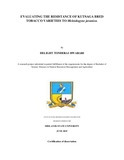Please use this identifier to cite or link to this item:
https://cris.library.msu.ac.zw//handle/11408/2129Full metadata record
| DC Field | Value | Language |
|---|---|---|
| dc.contributor.author | Hwarari, Delight Tonderai | - |
| dc.date.accessioned | 2017-06-22T15:31:36Z | - |
| dc.date.available | 2017-06-22T15:31:36Z | - |
| dc.date.issued | 2015-06 | - |
| dc.identifier.uri | http://hdl.handle.net/11408/2129 | - |
| dc.description.abstract | Root-knot nematodes (RKNs) are of economic importance in tobacco production especially the specie M. javanica with increased virulence. Over the past decades chemical control has been effective in the management of M. javanica, but due to its negative impacts to the environment, among all management measures use of resistant varieties has an increased efficiency. This study sought to evaluate the resistance of Kutsaga Research Board bred varieties which are T 66, T 71, T 64, T 29 and KM 10 as a negative control. Determination was done comparing to a resistant tomato variety cv. Rodade containing Mi-gene that inhibits the penetration of some root-knot nematodes. The objective of the research was to evaluate the resistance of the different RKN resistant tobacco bred varieties to M. javanica, measuring parameters such as; the gall scores, root weight mass, foliage weight mass, number of second juveniles, number of third and fourth juveniles within the root and number of egg masses among the different varieties this was done at two weekly interval for ten weeks. The experiment was conducted in a Completely Randomized Design (CRD) with four replications. Seedlings were transplanted at six weeks into 6.5 cm diameter pots and 5000 M. javanica eggs were inoculated in each pot. Results showed that there were significant differences in galling rates; resistant varieties had low gall scores below the economic threshold value of 2 representing a very slight and trace galls up to 25 galls per root mass. However T 29 had higher gall score at week ten above 2, representing very trace galls but less than 25. T 64 and T 29 had lower root weights than other resistant varieties. T 66 had the highest foliage weights among the resistant varieties. In the J2s, J3s and J4s there were no significant differences among the resistant varieties but however T 66 had the highest number of J3s and J4s amongst the resistant varieties. In the number of eggs KM 10 had increased number however all other varieties had low numbers. The variety T66 had increased resistance among all the resistant varieties and T 29 had the least tolerance among all the varieties .It can be concluded that, use of certified resistant varieties in tobacco production increases yield and quality in tobacco production. | en_US |
| dc.language.iso | en | en_US |
| dc.publisher | Midlands State University | en_US |
| dc.subject | Meloidogyne javanica | en_US |
| dc.subject | Tobacco Varieties | en_US |
| dc.title | Evaluating The Resistance Of Kutsaga Bred Tobacco Varieties To Meloidogyne Javanica | en_US |
| dc.type | Thesis | en_US |
| item.grantfulltext | open | - |
| item.cerifentitytype | Publications | - |
| item.openairetype | Thesis | - |
| item.languageiso639-1 | en | - |
| item.openairecristype | http://purl.org/coar/resource_type/c_18cf | - |
| item.fulltext | With Fulltext | - |
| Appears in Collections: | Bsc Horticulture Honours Degree | |
Files in This Item:
| File | Description | Size | Format | |
|---|---|---|---|---|
| EVALUATING THE RESISTANCE OF KUTSAGA BRED TOBACCO VARIETIES TO Meloidogyne javanica.pdf | 730.93 kB | Adobe PDF |  View/Open |
Page view(s)
256
checked on Nov 4, 2025
Download(s)
148
checked on Nov 4, 2025
Google ScholarTM
Check
Items in MSUIR are protected by copyright, with all rights reserved, unless otherwise indicated.



